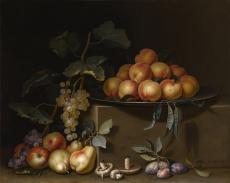


There are no extant written records to tell us about the life of Paul Liégeois, but his signature appears on numerous still lifes, among which one was dated to 1661 and two to 1666. The stylistic features of this painter, who most probably came from Liège, place him between the realist painters with their rigorous compositions, such as Louise Moillon (1610-1696), Lubin Baugin (c. 1612-1663) or Jacques Linard (1597-1645), and those, more decorative in the second half of the 17th century, such as Pierre Dupuis (1610-1682), who sought to animate their artworks. The inventory taken after the death of the painter Philippe de Champaigne (1602-1674) mentions a fruit still life painted by Liégeois, and his name appears in many other inventories of great 17th-century collectors, such as François de Boyer de Foresta, Seigneur de Bandol, in 1680; Simon Lenfant, counsellor of the Parliament of Aix; J.-P. Picard, Marquis de Joyeuse-Garde, dean of the Parliament of Aix; and Jacques Bailly (1659-1736), Painter to the King. Today, works by Liégeois can be found in the Uffizi Gallery in Florence, the Norton Simon Museum in Pasadena, the Louvre in Paris and the fine arts museums in Besançon, Chambéry, Dijon and Rouen.
All we know of Liégeois are his still lifes, essentially fruits and in particular peaches, apples, grapes and plums. He tackled, with a good deal of talent, these pieces of fruit in cold colours with fabrics of often acidic colours, sometimes fringed in gold, and by placing them in plates or baskets, or directly onto a stone or marble slab. The extreme sharpness of the contours of the fruit and the leaves is one characteristic of his work. Liégeois was certainly influenced by Willem van Aelst (1625 or 1626 – c. 1683), the Dutch artist who lived and worked in Paris before 1650, but he had a taste for tighter, more symmetrical compositions, which are reminiscent of his French contemporaries. Thanks to the effects of the light, Liégeois ushered in the most spectacular still lifes of the next decades, becoming an obvious link between Moillon and Dupuis. This painting in the A. G. Leventis Collection reflects all of Liégeois’ qualities by its exploration of colour contrasts and the sparkling light that bring out in particular the plums and the pears. The combination of the fruit depicted seeks to underscore the effect of the light on each one of them, playing with the yellow of the pears, the blue of the plums, the orange of the peaches and the white of the mushrooms and the grapes.
Little is known about this French still-life painter, who was probably from Liège and was active in Paris inthe mid-17th century. He appears to have been successful, particularly with depictions of fruit, as his nameappears in the inventories of several notable collectors of the time.